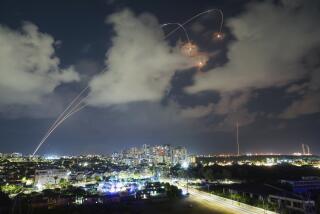Ill-Starred ‘Star Wars’ Tests
- Share via
It should surprise no one that the first test in two years of the “Star Wars” missile defense system fizzled Wednesday when a “kill vehicle” never left its silo in the Marshall Islands. The startling thing would have been if the $85-million test had succeeded.
Ever since President Reagan called for this ill-conceived system in March 1983, his conservative acolytes -- including President Bush -- have been determined to make it a reality despite widespread evidence of its impracticality. Two decades later, it has still gone nowhere despite Bush’s rash promise that he would have a limited system in place by the end of 2004.
The government has spent about $130 billion on the program and is slated to invest $50 billion more over the next five years. Yet the only tests that have succeeded were rigged; the missiles being intercepted were equipped with homing devices, something a real attacker probably wouldn’t be considerate enough to include. The most recent test before Wednesday’s, on Dec. 11, 2002, failed when a warhead didn’t detach from its booster rocket.
In the wake of the latest fiasco, Richard Lehner, a spokesman for the Pentagon’s Missile Defense Agency, claimed the test didn’t represent a failure of the system, simply a glitch. This is like a repairman telling you there’s nothing wrong with your car just because it won’t start, that it simply has a mechanical problem.
The Bush administration, though, isn’t budging. Defense Secretary Donald H. Rumsfeld, who headed a commission in 1998 warning about missile threats from North Korea and Iran, says a defense is vital. It isn’t. As Greg Thielmann, the director of the State Department’s Bureau of Intelligence and Research during Bush’s first term, has written in Arms Control Today, Rumsfeld contorted the evidence in 1998 to create a North Korean and Iranian missile threat to the United States where none existed, just as he would later do on the issue of Iraqi weapons of mass destruction.
It’s unfathomable how Bush can continue to talk about the need for spending cuts while embracing one of the least successful and costliest military research programs in recent memory.
More to Read
Sign up for Essential California
The most important California stories and recommendations in your inbox every morning.
You may occasionally receive promotional content from the Los Angeles Times.










